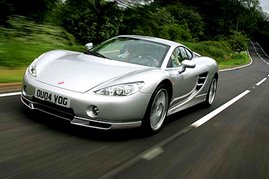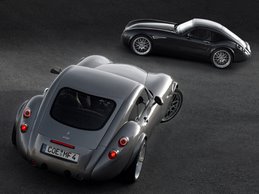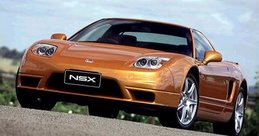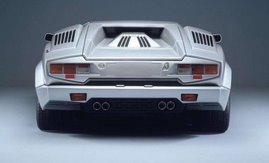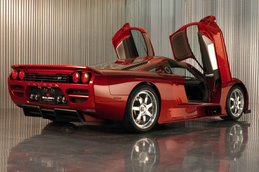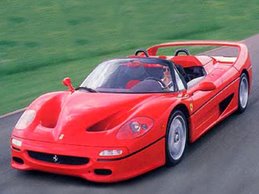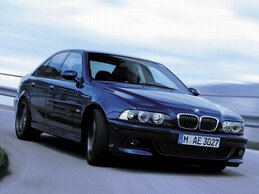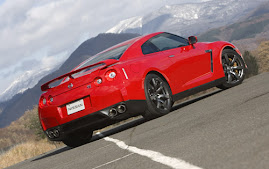skip to main |
skip to sidebar
By Bruce McCulloch
Though my father is probably the most passionate automotive enthusiast I’ve ever met, he is also one of the most traditional: not only in the sense that he prefers subtle designs, but traditional in terms of how he values his purchases.
First and foremost, my father has never been one to purchase a car for the benefit of the others; in other words, the Joneses down the street do not in any way influence what he likes, and ultimately, purchases. Nor is he one who cares about the latest in the world of technology and all that subsequently follows. And last, but certainly not least, he’s not one who is hung up in the fizzling power trends. His outlook on the matter is akin to: “so long as the car has enough pull for the road, and fulfills at least 95% of my needs (roll your eyes), I’m all-game.”
What does he demand in a car, you ask? Well, even despite the fact that he’s owned a number of performance vehicles – from Supras to MR2s – his ideal automobile has most always been a comfortable luxury cruiser. Other priorities on his list are not only reliability and quality, but an exterior that is unmistakably classy, yet understated at the same time.
When it comes to his yearning for bodywork perfection, don’t even get me started. Never before have I met someone so fussy as to turn down a vehicle for reasons pertaining to repaint, dents, misaligned window chrome and what-not. Mind you, he’s not alone in this regard, as I too have inherited his anal retentive obsession in search of the perfect vehicle. However, that’s its own long and dreary story.
All of this is without even taking into account his desire for long-term ownership. Rather than seeking a new trade-in every two or three years, my father always aims to keep his purchases for a minimum of five years.
That being said, he also takes a look into the possible annoyances of his purchase, and whether he’d be sick of the vehicle long down the road of ownership. Taking these strict set of conventions into mind, for a car to truly convince him enough to purchase, he must think the world of it.
So, a few weeks ago my father and I were casually cruising around the local Acura dealer here in Vancouver (Burrard Acura) and sitting there – in all its shinning champagne-coloured glory – was a previous generation Acura “RL 3.5”. You know, the one that was often criticized for being as exciting as an unsalted cracker?

Knowing that my father had always been a big fan of the vehicle, I knew we immediately that he would be seriously considering this car. The deal was especially sealed when he learned that it had just 55,000 km on its odometer, despite being delivered to its first owner in January of 1999. And take my word for it - the vehicle’s mileage is certainly representative of its cleanliness. My father has certainly had a vast selection of low mileage, well maintained vehicles before, but by God, this is on a whole another level.
Shortly thereafter, we took it for a quick spin up the freeway ramp – to test the pushing-power of that 3.5 litre V6, naturally – and in an instant, he was, or rather the car, was sold. Mind you, I should mention that he had sampled a nearly identical RL in the past year, and loved every moment of it; this meant that obviously he pretty much knew what to expect.
Exterior:

Evidently, the RL of this particular generation is far from being the most exciting looking vehicle on the planet, but if it’s any consolation, there isn’t much of anything that’s likely to offend even the toughest of design critics. And though I acknowledge that the design itself is rather simplistic in nearly all respects, I also think it happens to have a very classical aura to it; an aura that to my eyes is not only very respectable, but carries a non-flashy vibe. Certainly more of a non-flashy vibe than the equivalent year of the Lexus LS, which managed to come off looking like an over grown piece of Tupperware-designed with Cadillac influences in mind.
Truthfully though, I will admit that the vehicle is starting to show its age. With body mounted mirrors and an old fashioned rectangular styled grill, the RL does indeed look like a vehicle spawned from the previous decade. However, I’m not all that concerned by that and evidently, neither is my father. Indeed, the fact that the car does look as if it is from a forgotten era of automotive design – let’s be frank, people have short memories – makes the vehicle even more appealing for a traditionalist enthusiast such as my father. I fully do believe that this particular generation presents itself as a modern classic.
Interior:
As with the exterior of the RL, the interior design is starting to show its age too, but only gradually. I suspect that its general design philosophy is of the utmost class, and it does well to represent the vehicle’s various styling themes.
Since this is an Acura product, we had no concerns about quality nor assembly. This vehicle is fantastically finished all around: the leather is of rich texture and toughness; the plastics of the highest quality; the fit and assembly have been controlled to the uppermost of the company’s ability.
The all-around interior ambience is fantastic. The front seats are oh-so glorious, while the rear seat units are among the best I’ve ever sampled in any car. Not only are they very supple, but offer an unbelievable amount of leg room – even with the front seats full retracted backwards, it’s easy for one to stretch one's legs.
The heating system - and all of which subsequently follows - is not only well thought out, but extremely efficient in its operation. Other notable features include the excellent-sounding BOSE stereo system, and the impressive dash and console illumination.
Driving Impression:
Having had much experience with Japanese automobiles, I can personally attest that this particular generation of the Acura RL is one of the finest vehicles to ever come out of the land of the rising sun.
Those who thought the RL was merely a rebadged Honda with a ton of kit could not have been more wrong. Having sampled a large variety of Honda and Acura products – from Accords to TLs – I can firmly tell you that the RL is of a much different world than, let’s say, an Accord.
Sound Insulation:
I was particularly pleased by the sound insulation in this Acura. While it’s not “Lexus quiet” by any means, the insulation does a great job preventing tire chatter and unexpected wind noise from entering the cabin. Despite the rather old fashioned body style – something that you might expect would make the wind-aerodynamics of the car faulty - the car seems to do just fine balancing external air pressure. Engine noise within the cabin seems to be perfectly distributed, allowing a sweet sounding bellow without any harshness.
It’s all quiet, without being too quiet.
Engine & Transmission Power Delivery:
Power delivery from the 3.5 litre V6 is always brisk and when coupled with the excellent four speed automatic transmission, and makes for a rather seamless drive around town. Acura claims the 1999 RL develops 210bhp at 5,200 rpm, and 224lb-ft of torque at 2,800 rpm. Quite frankly though, I think the company is grossly understating the actual figures of the vehicle – for something that weighs nearly 3900lbs, it’s surprisingly fast and blunt. One is easily able find power any at rev range; whether that be in stop-start traffic or at 60 mph (100 km/h) on highway with help from Honda’s excellent variable valve timing system (VTEC).

The transmission of the vehicle is undeniably from a different world than a usual Honda product. Shifts aren’t quite Lexus seamless, but in the world of the Japanese auto, it’s the second-best transmission I’ve ever had the pleasure of sampling.
Handling/Control/Compliance/Braking:
As was mentioned earlier, the RL weighs nearly 3900lbs, but you certainly wouldn’t gather that impression on a first drive. For a car that not only weighs as much as freighter, but has the dimensions of one – not to mention that the vehicle is front wheel drive, rather than rear wheel drive – it’s quite a surprise to see how compliant the chassis is around the bends: steering is efficient and quick-handed; the chassis and tire combination allows for a proper variation between supple handling and a smooth ride; high-speed handling induces a touch of understeer, but certainly not as much as I had originally expected. All of this makes the RL not only of the best handling, but most controlled and compliant FWD vehicles I’ve ever had the pleasure of driving.
And when it comes to hammering the brake pedal, you need not worry as the braking system allows for an excellent amount of feedback and the brakes themselves prove more than adequately sized to stop the vehicle.
And then the shortfalls…

But of course, nothing is perfect and this Acura RL is no exception. By and large, there really is very little to annoy one’s self of temperament. While most everything is well though out, the absolute biggest of downfalls is – wait for it, it’s an odd one - is actually interior storage space, or more the lack thereof. For a car that has longitudinal dimension of 195 inches, there could surely be more storage space. The center console's volume borders on pathetic, while the side door compartments are downright laughable, but ultimately, the glove box just barely has enough space for the owners manual. It’s a pitiful shame. And though you wouldn’t think it would to be a too big of an issue, it’s proven to be quite a nuisance.
But other than those issues, I honestly cannot think of anything else that is overly tiresome or particularly annoying about this vehicle. Again, it’s not the perfect, but I can’t think of much about that isn’t exceptionally engineered and well thought out. When this generation of the Acura RL was first released in 1999 it was one of, if not the most, expensive front-wheel-drive car(s) on the market, but rest assured, that was for good reason.
If you’re a fan of Japanese vehicles, I definitely recommend checking one out.
By Bruce McCulloch

The ever-daunting question on the mind of any enthusiast: is there such thing as the perfect design? That special design that you consider just perfect, that design that you honestly think could not have been better?
Evidently, opinions on this matter are to greatly differ. Some enthusiasts think that there is no such thing as the “perfect” design; always implying that something can be “near perfect”, but not “perfect” per se. And on the same note, there are just as many enthusiasts who do indeed feel that there is such as the perfect design.
Now, obviously, us car-nuts are not going to find just one design that we’re all going to agree is perfect. That being said, finding the “perfect” one is of course all down to personal opinion and taste.
I found myself pondering over this question in my kitchen this morning, while eating my delicious left-over cold Hawaiian pizza (what else?). I thought to myself, “surely there must be at least one design that I consider “perfect”, and indeed there is. However, before I came to that solid conclusion, I did a little bit of a look-see into what some of my favourite automobiles were.
And with that on my mind, I was able to come up with a small list of my favourite cars that boast designs that I just happen to love for one reason or another. The first of many which came to mind was that of the Pagani Zonda. If you read my articles on a regular basis, you’ll by now know that I’m highly fond of the Pagani Zonda’s extroverted insaneness when it comes to its exterior. But then I thought, “No” - as much as I like the Zonda, I cannot say that it is the perfect design in my eyes.
But surely, there must be some other considerations from the great (and stylistic) country that Italy is. Well, to be honest, I’ve never been all that fond of the designs that come out the wine-grove. Of course, to say there are no designs from Italy that I appreciate would be trite. I mean, who could ignore such stylistic greats such as the Ferrari 257 GTB/4, Maserati Bora (a personal favourite of mine) and the Lamborghini Miura? But even though I have great deal of appreciation for those designs, I’m going to have to pass on the prospect of referring to any of them boasting a “perfect design”.
Shortly thereafter, I gave thought as to some of my favourite German metal and their many fantastic designs. The BMW Z8 immediately came to mind, as did Porsche’s 993 Turbo and their exclusive flagship, the Carrera GT. Though the three are of an entirely different design language, it must be noted that they’re all so equally fantastic. I had thought that the 993 Turbo with its quirky design and solid-brick metal made finding that perfect design all that bit easier, but then I thought that about the Carrera GT too...
And one cannot forgot such greats from Mercedes-Benz as the good ‘ol 560 SEC and in modern times, the 2008 CL-Coupe. Though, as great as they are, I don’t feel as if I have that whole “spiritual-connection” thing with either of two.
So then, over to the great isle of the United Kingdom and see what they’ve to offer. Well, there are the obvious candidates such as Jaguar and Aston Martin. These two manufacturers have been offering some of the most jaw-slackening metal over the last, oh, some 70+ years. With Jaguar on the map, there’s certainly no shortage of eye-candy; examples such as the XK120 SS, the E-Type and even the XJ220 are proof of this. Naturally, Aston Martin certainly doesn’t disappoint in this regard either. With early-day giants such as the DB4 and the DB5, you might wonder why one (particularly myself) should be looking elsewhere for that perfect design. And then advancing into a more modern era, you’ve got such vehicles as the V8 Virage, the Vantage 600, the DB7 GT and even modern greats such as the DB9 and the V8 Vantage. I must admit, the latter two in this long line of amazing cars, were of great consideration for my pick of the perfect design. These two luxurious GT’s are so perfectly designed from an exterior point of view that it’s hard to find any real faults.
I mean, quite honestly, can you think of anything on the design of either modern-era Aston that’s likely to offend?
Or, if crazy fits your tee, there are always specialist manufacturers such as TVR, Noble and the recently-closed Marcos. All three offer a look into a very different world of design philosophy, and they’re undoubtedly interesting, but are any of them perfect per se? No, I don’t believe so. The vast of them are just too fussy and convoluted to be considered a perfect design in my eyes.
That being said, I suppose it’s only fair for me to explain how I’m judging my criteria for such an honourable award. For me, the perfect design must be, well, perfect. Perfect in the sense that when I see one in the street, I get that good old car-nostalgia; you know; that feeling that you had when you found your first “car love”? A feeling that makes you say think to yourself: “it’s perfect”; “it’s timeless”; “its classic”; “they couldn’t have done it any better”.
And being naturally biased towards Japanese automobiles, I thought I’d take a look over into the country of the Rising Sun and see what lies-in-wait. Toyota being my natural preference when it comes to Japanese autos, I assumed that would be the place to find that perfect design I ever-so seek.
Naturally, the first of many impressive designs that came to mind was that of the Toyota 2000GT. I love this car with a great passion and quite frankly, think it looks just as, if not better than many Italian supercars. With its small proportions and sleek body, Its design is nothing short of lustful. In other words, a worthy contender, you might say.
Meanwhile, more recent designs such as the Celica of 1985 and the Lexus SC400 of 1991, are also very influential and do well to get my motor-inspired heart running at high speeds. But still, I feel there’s something missing; that degree of allure I’m looking for seems to be non-existent in either of those designs.
Nissan has offered a-many interesting designs since it’s founding, but nothing that I deeply desire to be honest.
So, that can only leave one car company left – Honda and affiliated. I must admit – that by and large - to regarding Toyota higher than Honda, but when it comes to designs, I find myself less annoyed with Honda’s themes. Thus my point being, I not only find Honda designs to be a tad more interesting, but also less fussy and ultimately, better looking than Toyota’s.
The NSX is one of those cars, which in my eyes, is just simply amazing. It’s one of those cars that I never tire of – seeing one on the road always induces the same jaw-slackening response from my face. And as much love as I have for the NSX, I’m going to have to pass on the prospect of naming it the perfect design.
But then one particular car came to mind… It’s a car that I must admit to being highly biased towards because my father owned one a couple of years back. And I’m not going to lie, it’s a choice which will surely shock enthusiasts world wide.
Hints: It’s from Honda; it’s small; it’s RWD; it has a four-cylinder engine and it’s a roadster. If you’re familiar with Honda’s history, you know that these characteristics reduce the overall tally to just a few choices: the S500, the S600, the S800 and the S2000.
And the winner is?
Honda S2000:
First generation (Year: 2000-01)

Now, I haven’t any doubt that enthusiasts reading this are going to be wondering what drugs I’m on and how I could possibly place this understated roadster from Honda (of all companies) as my perfect design; even after I’ve ignored such vehicles from Porsche, Aston Martin and Ferrari.
Though, I can’t say I’d blame anyone for wanting a bit of explanation as to my rather surprisingly (and oddball) choice. I specifically remember the day when my father went to dealer to test drive his then later S2000, and as the car had just two seats – I had to be left behind while my father and the dealer took it out for a spin. Disappointing? Surely, but as the car pulled away from the dealer, I had some sort of an automotive epiphany which made me see the S2000 in a different light.
Oddly enough, I had this same epiphany a few months later: as the sun began to set on a warm and vibrant day, the glow of the halogen bulbs and the Silverstone Metallic paint gave off a strange aura. An aura I can only describe as seeing the vehicle as some sort of design perfection. I looked at it and not only thought, “my dear, could they have done that thing any better?”, but I also remember thinking, “I can’t believe that thing isn’t worth twice what its MSRP is”. Dramatic you say? Well, surely it is, but hey – it works for me. It’s still something that I happen to believe to this day. Whereas others might see the S2000 as some low-grade roadster with an understated (perhaps even boring) design, the vehicle in my mind looks to be quite high-class. It’s not a forceful design by any means, but it’s very well conceived; its proportions are all very well thought out with nothing looking too “out there”. As a result, I also happen to feel to the S2000 is quite timeless. Despite the fact that it’s been on the market for nearly eight years now, I don’t think it has managed to date even the least bit; it still looks every bit as fresh today as it did when it was first released.
And as I mentioned above, its proportions are just sublime. Take a look at the front fender, for instance – it’s hard edged, thus keeping the design blocky and compact at the front, whilst managing to give the car a style-theme that gives the nose the classic appearance expected from any front-engine sports car. The under-grill arrangement, albeit simple, looks to be simply awesome. All of which makes for a very clean component of the design, which naturally matches perfectly in-line with the vehicle’s headlamps.
The side profile is really no less impressive with its interesting mix of classic sports car cues, which yet at the same time, manage to be undeniably Japanese. The front end is just right, the windscreen height it set perfectly in cue with the bonnet and the rear is classically short, without being too short. Even the mirrors fixed on the body rather than connected to the windscreen A-pillar, do well to illustrate that the S2000 is indeed a sports car.

And speaking of the rear-end, I cannot for the life of me think of anything that I do not like about it. The exhausts, the diffuser, the light-bar and the tail-lamps are all so perfectly laid out; the latter of which especially with it’s multi-coloured arrangement of lighting. Even the way in which the white coloured lamps divide between the reverse lamp and the signal lamp (orange signal on top, white reverse on the bottom) of the circle is too –oh, how should we say it? – awesome (again). The roll-bars are also well thought out as they are not only functional (as they bloody well should be), but happen to look just right; not only are they not tacky, but they’re – unlike the vast of roadsters - not too big either.

When Honda gave the S2000 a relatively small facelift in 2004, I must admit that I had felt perfection had been needlessly toyed with. Certainly, I understand the need to boost the sales of the already exclusive vehicle, but I couldn’t help but feel that what was added was just knick-knack. Don’t get me wrong, the facelift produces what is still a great looking car, but the original seemed so much more authentic.
When Van Gogh painted his all-famous “The Sunflowers”, did he know what he was onto? After all, he painted so many iterations of this fantastic painting, one has to wonder. His first - painted in 1888 – with its vibrant 12 flowers is undoubtedly his finest, but in the following years Van Gogh completed six more versions. But none of them had the impact of the original. And the same can be said for the Honda S2000. I believe Honda struck perfection when they designed the first generation S2000, and I believe they’ll never top it.
 By Bruce McCulloch
By Bruce McCulloch
Suffice to say, it’s an interesting moment in time for the Japanese motor company that is Toyota. Never in their some-60 year history has the company ever had such recognition. As most enthusiasts are already aware, Toyota is now the world’s biggest automotive manufacturer, and much of this can attributed to Toyota’s great value as automobiles, consistency of goods, but ultimately, their quality and reliability.
But of course, not all things can last and with Toyota’s stratospheric growth over the last decade or so, the company now has to contend with a series of appalling growing pains. Through the 90’s for instance, Toyota was a company with more or less of a spic-and-span clean reliability sheet. And not just overall reliability, but everything from quality to recalls. I’m not implying they were perfect by any means, but in contrast with today’s Toyota, they seemed to be miles ahead.
Obvious fault aside, not all is bad for enthusiasts of the brand. Oh no, in fact Toyota has been feeding us Toyota-nutters a decent dose of car-candy over the last couple years, and by that I’m referring to Toyota’s new aim/direction on sportiness. And as is well-known, sportiness –or the lack thereof – has always been a great criticism of company. Not anymore though, especially as it’s clear that Toyota of the future is aiming to capture the hearts and minds of more enthusiasts than they ever have before.
Now, of course, that’s not to say that Toyota’s history is completely oblivious of sporty cars. I need not remind anyone of such greats as the 2000 GT, nor the Celica, the Supra or the MR2. They’re cars which not only changed the general perception of Toyota as an automobile company, but contributed a great deal towards promoting the Japanese sports car.
Truth be told though, Toyota has most always stayed in the conservative arena in regards to developing sporty vehicles. Especially in comparison with not only rivals from around the world, but even fellow country manufacturers such as Nissan and Honda. And as we entered the ‘90’s, it was clear that Toyota had little, if any, intention of promoting the brand as anything to do with sport. As Lexus had just been introduced as the alternative to German luxury with the added kick of stronger reliability, Toyota its self concentrated on promotion of its bread and butter vehicles – the Camry and the Corolla to be specific.
In those years, focus and promotion of “sport” models slowly headed towards the bright light of death. The MR2, for instance, which had been known as a blistering go-kart with a seat-of-the-pants ride, turned into something much mushier with the release of the early 90’s generation. Whereas the late 80’s model had considerable focus on small dimensions and it possessed true sports-car genes, the MR2 Turbo was much more indolent in comparison. And it was the same story for the 90’s generation of the Supra. The MK2 of 1985, was tight, well-heeled and offered a great deal of road connection, whereas subsequent generations seemed to be ever-so dampened in regards to sport. Don’t get me wrong, both the MK3 of the late 80’s and MK4 of the early 90’s were indeed great cars, but it seemed as if the Supra was not only getting more powerful and bigger, but ultimately, becoming a grand touring vehicle. There’s little doubt that Toyota was purposely treating the 4th generation Supra as a higher force amongst the automotive world, when in my home country (nowhere other than the “Great White North”), the mid 90’s GT was a full $20,000 more expensive than the preceding model.

And yet, oddly enough, one of the Toyota’s most impressive “sport-oriented” vehicles was the one that looked to be the exact opposite – the “Cressida” (particularly the last generation -1988-1992). And the irony of that remains that the Cressida was always one of the brand’s most criticized vehicles; a vehicle often described as being both “tedious” and “nondescript”. In all fairness though, the Cressida’s exterior did very little to give anyone a clue as to what the car was really like. Though you need not take my word for it, just ask its owners who often referred to the car as “a 4 door Supra”. Although, in my honest opinion, the Cressida was actually the better of the two vehicles when it came to offering thrills. Not only because it was amazingly well balanced, but boasted a great deal of connection to the road; all in all, a Japanese BMW if you will.
And as the century came to a close, Toyota’s sporty line-up of vehicles became pretty much non-existent. Not only had the Supra since long been put out of production, but the MR2 had further turned into a hairdresser's fashion accessory with the sex appeal of a toad.
Additionally, Toyota had always been a company who had been quite conservative on power figures in the past. Whereas the Americans and the German’s had been a tandem of power wars, the Japanese auto firm always managed to stay in the background with very few of their vehicles breaching the 300bhp mark. Evidently, Toyota wanted nothing do with creating powerful and sporty cars, but that all was eventually to come to an end.
Fast forward to the turn of the 20th century, and you’ll notice Toyota is attempting to not so much as change its old ways, but create a new division of status to attract a new demographic of young and hip enthusiasts who are interested in sporty body kits and flashy bits of kit. Vehicles such as the Matrix, the Yaris and the FJ Cruiser are all evidence of this particular swing towards the direction of sport. Even the all new 2009 Corolla – arguably the most boring of all Toyotas – looks decisively more sporty now, much more than it ever has before.
And need I even remind anyone of Toyota’s lastest and hippest brand aimed purely at the youth of America, Scion? With Scion, Toyota has been able to create a car just for those crazy modification junkies who like to race, or, simply be seen as cutting-edge in the downtowns of our cities.
Lexus:
As has been evident by the lineup, Lexus has never been about being even the least bit sporty. In fact, Lexus has always been just the opposite – the brand for those who don’t care for sport and flash, but rather understated designs, seamless luxury and comfort. And why would anyone expect anything else when the company has built a very solid reputation on just that?
For the longest of time we had seen Lexus’ great reluctance to give their cars the proper power boosts they deserved. That all seemed to change however, with the release of the 2nd generation IS compact-saloon in early 2005. Whereas the 1st generation IS was a decent attempt at dethroning the BMW 3-Series, the subsequent generation has been a much stronger effort. It’s an effort which not only proved that Lexus could develop a vehicle that little bit closer to the 3-Series, but also one capable of out-gunning it; do take note that the 2005 IS350 was the first of the compact-saloons to possess over 300bhp.
Meanwhile, the introduction of the 4th generation LS flagship saloon has revealed that the company has now decided to bring their personal power game to a whole new level by allowing it not only breach the 300bhp mark (380bhp to be exact), but even the 400bhp mark with the LS600h (430bhp to be exact).
The Beginning of the sporty Lexus - The IS-F:

Thanks to Toyota’s hushed nature in regards to building sporty cars, there were a lot of folks who had (understandably) dismissed the idea of a true thoroughbred sports-saloon from Lexus. With the release of the 2008 IS-F however, Toyota’s engineers and determination cannot be faulted in any way.
As an enthusiast of the brand, I knew things were a little different this time around; in other words, none of that false “slap on a body kit and install a big engine thus eventually leading to slapdash, uninhibited handling”. It was clear that with addition of 14.2-inch Brembo brake callipers at the front end, 255mm Michelin tyres at the rear, BBS alloys and a suspension a full inch lower than the standard item that this IS was a serious effort. But of course, the question remained: would the IS-F be a true sports saloon, or just another hash attempt?
Initial doubts aside, the IS-F has done well to prove disbelievers wrong. Magazines from the colonies such as “Road & Track” and “Motor Trend” have had much praise to give this new super Lexus. Implying that it’s everything that one did not expect from a Lexus – it’s harsh, rough and angry while adding a degree of sporty finesse. One magazine described the car as being even too “hardcore” for the road – and remember, this is a Lexus we’re talking about here, not a Lotus. Yet other magazines have described the car as being truly hardcore, whilst still retaining a great deal of the brand’s usual road characteristics.
Meanwhile, even scores of European journalists –arguably the harshest of critics when it comes to Lexus vehicles – have given the IS-F a very fair amount of positive press.
The performance figures you ask? Since when was a Lexus capable of hitting naught-to-sixty in just 4.2 seconds (* Road & Track)? Never before is the answer, and that’s exactly what takes the company to a whole new level.
And that is all without even mentioning the interior, or the exterior design of the vehicle. Its little secret that Lexus’ are often criticized for their rather safe and understated designs, but the same cannot be said for the IS-F which manages to be aggressive throughout the entirety of its design detailing. Some even feel that the new super IS a bit too flashy for even a Lexus.
And what about the LF-A supercar expected to arrive some time in 2009? Watch out folks, watch out.
The obvious verdict being that things at Toyota are indeed changing, and in a manner which is very positive for enthusiasts. I’m not implying that Toyota will change its ways overnight, but its clear there’s a new direction for Toyota and affiliated on the horizon. As one of Toyota’s very biggest fans, I’m happy to see it and I am really very much looking forward to next few years of Toyota and Lexus products.











